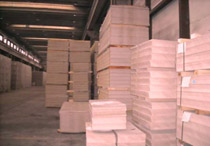Psysical Proprierties Of The BetonWood Building Boards
The panels in cement bonded are realized in conglomerate cementizio "Portland" (the only concrete that does not contain Radon) and Wood Fibers of Pine to 100% press. The quality, is guaranteed by the greater institutes of certification of European qualities.
Dimensions of the BetonWood building boards

- Lenght: 3200 mm, 2800 mm, 2600 mm
- Width: 1250 mm
- Usual thickness: 8,10,12,14,16,18,20,24,28,40 mm
The building boards BetonWood join the favorable characteristics of the concrete with the characteristics of the wood. The structure of the plank is realized with swarfs and fragments of wood that go to form the advanced layer in both sides, until a rough layer in the central part. The superficial ones of the edges are smooth, with a color gray, when the produced one does not endure smoothing workings. For sanded building boards, the tolerance compared to nominal thickness is uniformly +- 0,3 mm. By special agreement boards with thickness other than given above can be supplied in 8-40 mm thickness range.
Density Of The BetonWood Building Boards
In conformity with requirements of Standards EN634-2, Item 2 the density of baords should be more than 1000 kg/m3. According to relevant test results at a temperature of 20°C and a relative humidity of 50-60%, and at a board moisture content of 9%, the density of the BETONWOOD building board is §= 1350 +- 75 kg/m3
For static calculations (for security reasons) it is recommended to increase or decrease the maximum value of density by 20%.
Water And Vapour Absorption Of The BetonWood Building Boards

It is known that the moisture plays the most significant role in the destruction process of a wood chipboard. It is very important to determine the laws of water absorption and transmission as precisely as possible.
When testing the cement-bonded chipboard in conformity with standards MSZ EN 317 the thickness swelling after 24 hour soaking is 1,5%.
The two planes of the cement-bonded chipboard are usually subjected to asymmetrical climatic load. A test has been conducted under the following extreme conditions: the upper side of a test specimen freely placed in a water bath was brought in contact with air space of t = 20 +- 2°C temperature and § = 65 +- 5% relative humidity.
Airborne Sound Insulation Of The BetonWood Boards
The cement-bonded chipboard in itself is not suitable for acoustical purposes. Favourable airborne sound insulation can only be achieved by proper structure design.